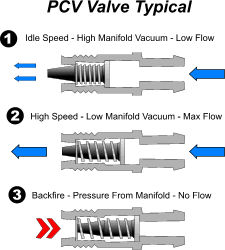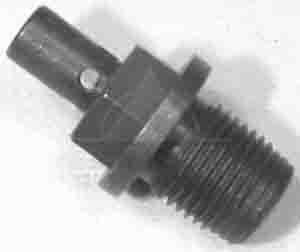Positive Crankcase Ventilation is
a system that was developed to remove harmful vapors from the engine and to
prevent those vapors from being expelled into the atmosphere. The PCV system
does this by using manifold vacuum to draw vapors from the crankcase into the
intake manifold. Vapor is then carried with the fuel/air mixture into the
combustion chambers where it is burned. The flow or circulation within the
system is controlled by the PCV Valve. The PCV Valve is effective as both a
crankcase ventilation system and as a pollution control device.
PCV systems have been standard equipment on all new cars since the early
sixties. Prior to 1963 PCV was only used in California. There are a variety of
PCV systems used on various makes and models of cars produced since 1963, but
all function essentially the same.
PCV systems can be described as either open or closed. The two systems are
quite similar. However, the closed system in use since 1968 is more effective
at air pollution control. The systems differ in the manner in which fresh air
enters the crankcase and excessive vapor is expelled.
Open PCV Systems
The open system draws fresh air though a vented oil filler cap. This presents
no problem as long as the vapor volume is minimal. However, when the crankcase
vapor becomes excessive it is forced back through the vented oil filler cap
and into the open atmosphere. The open PCV system, though successful at
removing contaminated vapors from the crankcase, is not completely effective
as a pollution control device.
Closed PCV Systems
The closed PCV system draws fresh air from the air filter housing. The oil
filler cap in this system is NOT vented. Consequently, excess vapor will be
carried back to the air filter housing and from there into the intake
manifold. The closed system prevents vapor, whether normal or excessive, from
reaching the open atmosphere. The closed system is very effective as an air
pollution control device.
The PCV Valve
The most critical part in the PCV system is the flow control valve, commonly
referred to as the PCV valve. The purpose of the PCV valve is to meter the
flow of the vapor from the crankcase to the intake manifold. This is necessary
in order to provide proper ventilation for the crankcase, while not upsetting
the fuel/air mixture for combustion.
Blow-by gases and vapor should be removed at about the same rate they enter
the crankcase. Since blow-by is minimal at idle and increases during high
speed operation, the PCV valve must control the flow of vapor accordingly. The
PCV valve is designed to compensate for the engine ventilation needs at
varying engine speeds. It is operated by manifold vacuum which increases or
decreases as engine speeds change.
For example, at low or idle engine speeds manifold vacuum is high. This pulls
the plunger to the extreme forward position, or manifold end of the valve. Due
to the shape of the plunger, vapor flow is reduced to a minimum. The low rate
of the flow is adequate for ventilation purposes and will not upset the
fuel/air mixture ratio.
At high speeds manifold vacuum is decreased. The plunger is only drawn to a
point about midway in the housing. This allows a maximum flow of vapor. Since
the engine needs more fuel/air mixture at high speeds, the introduction of
more vapor does not affect performance. In the event of a backfire, pressure
from the intake manifold forces the plunger to the closed or engine-off
position. This prevents the backfire flame from reaching the crankcase and
exploding the combustible vapor.
A neglected PCV system will soon fail to function and the result can be
expensive as well as troublesome for the car owner. If the crankcase is not
adequately ventilated, the motor oil will quickly become contaminated and
heavy sludge accumulations will begin to form. Internal parts, not protected
by the motor oil, will begin to rust and/or corrode due to the water and acids
that will become trapped within the crankcase. If the PCV system is not
functioning properly, the flow of crankcase vapor into the intake manifold
will not be properly metered. This, in turn, will upset the fuel/air mixture
for combustion and cause rough idling or even stalling of the engine.
Furthermore, intake and exhaust valves, in addition to spark plugs, may well
be burned and rendered useless, prematurely affecting performance and
requiring expensive repairs. To assure trouble-free performance of the PCV
system and, in turn, the engine and vehicle, routine maintenance of the PCV
system is absolutely recommended and required.
A PCV valve should never be cleaned and placed back into service. Cleaning a
PCV valve will result in a clean PCV valve; not a new PCV valve. There are
contaminants that will remain in the PCV valve that can never be flushed out.
Additionally, there is an amount of wear that will be experienced by the
spring that cleaning cannot replace. The recommended replacement intervals are
a maximum of 12 months or 10,000 miles (16,000 km). Since vehicles and
operating conditions vary, the valve may have to be serviced more frequently.
If it is suspected that the valve is sticking or if there is evidence of
sludge, the valve should be replaced.
All hoses or tubes used in the PCV system should be cleaned and inspected. If
any cracks or breaks are noticed in the hose, it should also be replaced. All
hose connections should be inspected to assure an air-tight seal.
Proper servicing of the PCV valve system will help reduce overall vehicle
emissions.

